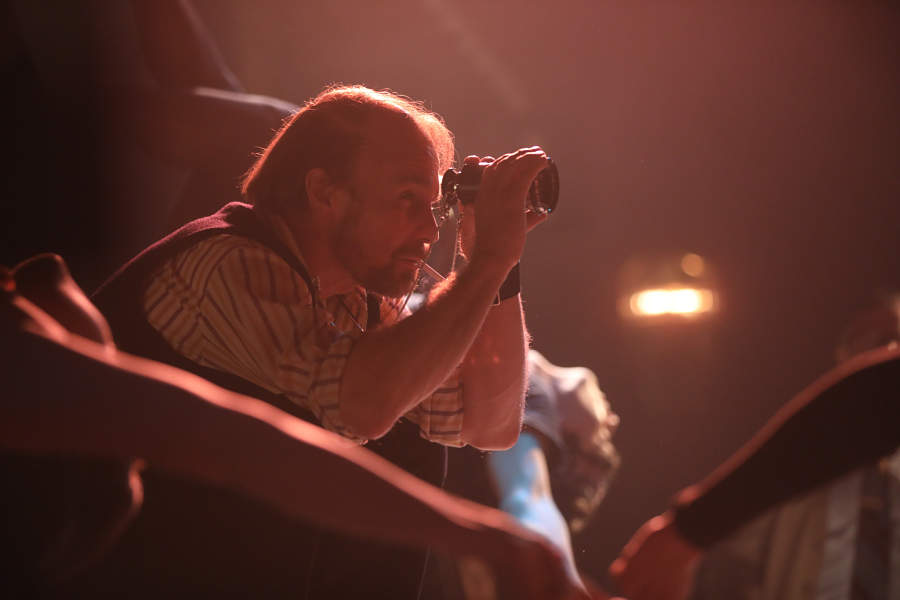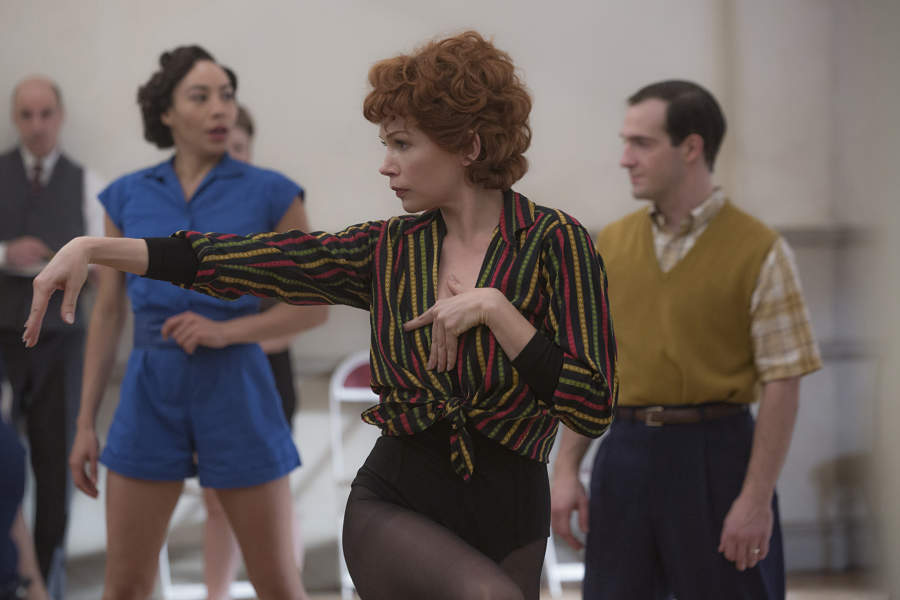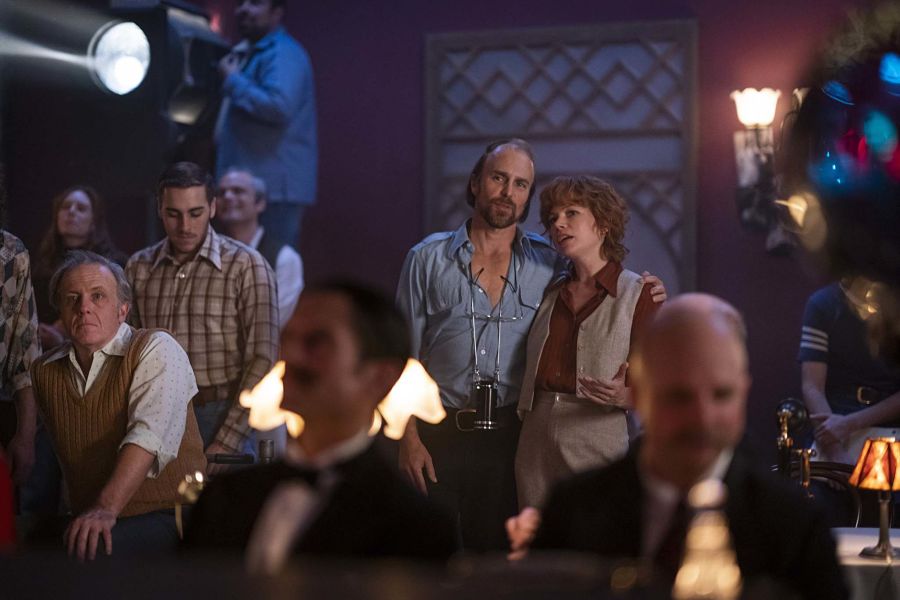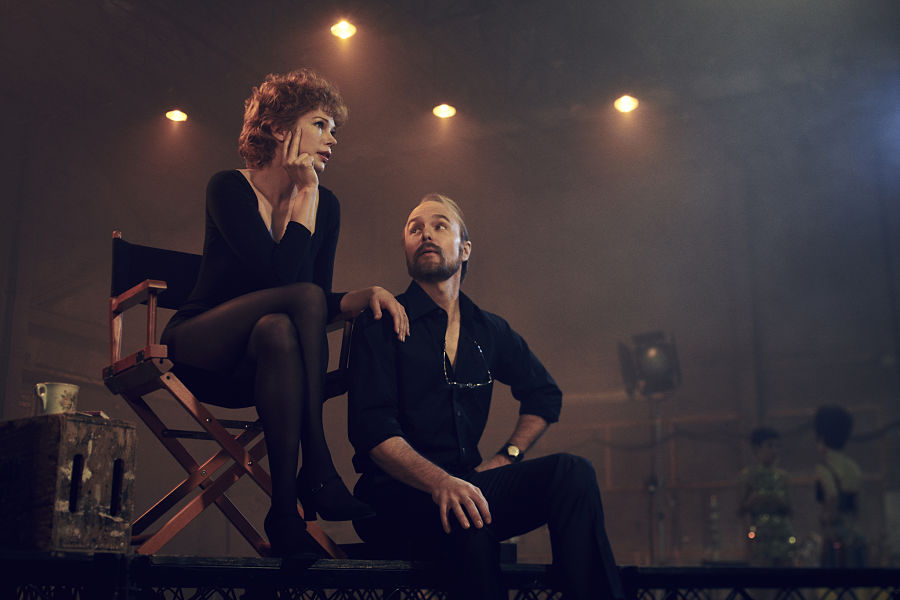This is not quite the truth: Some weeks ago I was ushered into a smoke-filled screening room, asked to sign a release form, take a blood test, and perform one uptempo and one ballad. Only then was I allowed to see the first five of eight episodes of the avidly anticipated limited series “Fosse/Verdon,” which starts airing on FX Tuesday, April 9. (Fact-check: I was sent a password-protected link to advance screeners I watched on my laptop.)
Dear reader, I have questions. Did I just see what I thought I saw? Will my life hereafter be divided into the time before I saw “Fosse/Verdon” and the time after I saw “Fosse/Verdon”? And do I really have to wait another month to see episodes 6 to 8?
I have some provisional answers. The first is this: “Fosse/Verdon” may be one of the best things on television in a long time, and not just for its locked-in niche audience of theatre geeks and show queens. So much of it leaps off the screen like a fishnet-sheathed leg extension, not least the combustible chemistry of Michelle Williams as Gwen Verdon and Sam Rockwell as Bob Fosse. Though they don’t much resemble the stars they’re playing—they look more like Shirley MacLaine and Robert Duvall, respectively—they have conjured two intertwined showbiz spirits and filled them in with flesh and blood and filigree. Indeed their performances evoke not only the old-school glamour of 1950s theatre and film but the grit and emotional realism of late ’60s and ’70s cinema, Cassavettes and Altman super-collided with Donen and Minnelli.
There are some flat-footed moments. It churns through its share of biopic backstory tropes (flashbacks to ragey parents shaming our leads’ younger selves for showbiz dreams) and famous-person-saying-who-they-are groaners (Norbert Leo Butz as Paddy Chayefsky: “In certain circles I am considered to be a major American dramatist”). Many of its reality-blurring musical-dream gambits are essentially stolen from All That Jazz (but why not steal from the best?). And not every moment or story arc thrums with the febrile electricity of its best scenes.
Much will be made of the power-sharing dualism at the heart of the project (as I did in another review), and rightly so. It’s among the most interesting, even revolutionary, things about this project, and yes, it definitely has something to do with #MeToo. As you prepare to spend a little time with “Fosse/Verdon,” here are eight of my takeaways, one for each episode (though did I mention I’ve only seen five?). And warning: Spoilers abound.
Fair warning: It starts on a low note. I don’t mean that Episode 1, “Life Is a Cabaret,” is bad, exactly, though I was nagged throughout by the thought, “Is that all there is?” It turns out that that Peggy Lee refrain isn’t far off from the intended mood, as the series begins in the late 1960s in Hollywood with a 40-something Bob Fosse directing the film of Sweet Charity minus its original Broadway star, Verdon, though with her support and on-set assistance. When Charity founders at the box office, it only gives the director/choreographer yet more fuel for his crippling self-doubt, which means he must labor to convince Cy Feuer (Paul Reiser, cheerfully delivering every movie-producer cliché Steven Levenson’s script hands him) to give him the job of directing what will be his masterpiece, the film of Cabaret. This career impasse finds Rockwell’s Fosse brooding and looking heartsick a lot, with tap-dance drills of his youth hounding his memory and Verdon passively suffering by the phone. Uh oh…Is this series going to be all about a dark, tortured genius and the (mostly female) lives he destroys—a Broadway Breaking Bad?

The other side of that forward slash gets her due, and then some. Whew! Episode 2 proves to be as sharp and lively and promising as Episode 1 was downcast and worrying. It takes us back to the first meeting of these two young hoofers as they’re about to begin their ascent into musical theatre royalty, which is rich enough material on its own. But it also has the great virtue of giving a bona fide star entrance to Michelle Williams’s stunning turn as Verdon, in a performance that is the oxygen of “Fosse/Verdon” (making Rockwell’s Fosse its carbon dioxide, or monoxide, more like it). But the way Levenson and director Thomas Kail intercut the past with the story’s present—in particular the relay race of Verdon’s entanglement with Fosse, as he trades in his second wife, dancer Joan McCracken, for Verdon, then appears to be pulling a similar bait-and-switch on Verdon years later—is shatteringly on point. It even makes some sense of the gamble of opening with droopy-dog Episode 1; the intent seems to have been to cover Fosse, then Verdon; dark night of the soul, then piercing sunshine. A note of caution: Just try getting the infernal Damn Yankees trifle “Who’s Got the Pain?” out of your head after this one.
Backstory blues. In my review of the show for America magazine, I called it a “rivetingly unstable compound of biopic, prestige cable drama, and musical comedy.” The first ingredient in that recipe—biopic—provides most of the series’ more routine moments of exposition and over-explanation. Episode 3, for instance, trots out some childhood-trauma flashbacks for young Gwen, though they are not without their added value: While her unhappy first marriage is alluded to in Sam Wasson’s Fosse, the meaty biography that is the series’ inspiration, “Fosse/Verdon” adds fresh and troubling details (and gives Santino Fontana a chance to play against type as a Grade-A heel).

Magic to do. In what will surely be one of the most-talked-about moments in the series, Episode 4, scripted by Tracey Scott Wilson, concludes with a moment of song-and-dance fantasy borrowed partly from Pippin but mostly, in spirit, from Fosse’s batshit 1979 roman à clef All That Jazz (not available to stream, by the bye). It’s fun to see some dancing that does more than simply recreate iconic Fosse stage and film routines, as series choreographers Andy Blankenbuehler and Susan Misner do faithfully elsewhere, though this flight of fancy (which is Misner’s work) is likely to be fairly rapped for exemplifying the series’ shifting hodgepodge of tones and styles.
The bottle episode. After four episodes of montage and flashback, Episode 5 mostly stays put over a rainy weekend at a Southampton beach house, with the ostensible occasion being an effort to cheer up newly widowed Neil Simon (Nate Corddry). But the real point is to work us up for the penultimate chapter of the tale, in which Fosse’s deadly workaholism will get its ultimate test: On one side is Verdon’s ambition to create the stage show Chicago as a vehicle for herself, and on the other is his ambition to leave behind the old razzle dazzle and be taken seriously with his first non-musical, the Lenny Bruce biopic Lenny. Which will he choose? And speaking of choices, might the series soon need another forward slash to become “Fosse/Verdon/Reinking”?
Bechdel test failure. The centerpiece of Episode 5, titled “Where Am I Going?,” is a heart-to-heart between Verdon and Ann Reinking (Margaret Qualley), in which every thought from these two brilliant woman revolves all around Bobby-baby: his needs, his genius, his difficulty. And it struck me that for all the equality implied by the show’s title, and the screen time and moral weight it gives to Verdon, this is still the story of the relationship between artist and muse(s), working within a system that will always reward or excuse his excesses while punishing a woman’s slightest misstep, especially the ultimate crime of growing older.
But writer Charlotte Stoudt has Verdon shrewdly stare down this structural inequity. When Reinking asks her what she got in return for all of Fosse’s cheating and lying, other than a daughter (Nicole Fosse, who serves as co-executive producer on “Fosse/Verdon”), Verdon replies with a list of other important names, of roles she created with him: “Not just Nicole. Lola. Charity. Roxie.” If that sounds transactional, it most definitely is, but it’s not only that. It rounds out a rich and complicated portrait of a creative marriage—a true partnership that, if it was never entirely equal in its distribution of labor or acclaim, was nevertheless an ineluctable fusion, so much more than the sum of its parts.
Here’s where the argument for more equitable storytelling can rest its case: Centering often marginalized narratives, which in this case means giving Fosse’s women plausible claims not only on his heart but on his art, doesn’t just make a show more fair or more “woke”—in this case it also makes it infinitely more interesting.

King of all media. It wasn’t just Fosse who straddled film and theatre, moving freely and frenetically between the soundstage, the rehearsal hall, and the editing room. Though she found her true métier on New York stages, Verdon grew up and started dancing in Culver City, at a time when musicals were nearly as likely to be made in Hollywood as on Broadway (and her spidery performance as Lola is forever preserved in the film version of Damn Yankees). If projects like this series—and The Greatest Showman, Mary Poppins Returns, and La La Land, etc.—keep getting made, today’s young Verdons and Fosses may find themselves employed all over the media. Talk about win-win.
The Ouroboros dance. Given that Fosse essentially already told a version of his life and death in All That Jazz (did I mention it’s not currently available except as a DVD?), I wondered if “Fosse/Verdon” had anything to add apart from the equal time for Verdon. No question it meets that bar and soars beyond it.
Still, I’ll be curious to see how the series treats the hall-of-mirrors moment when its Fosse makes a movie musical about himself, casting actors to play versions of Verdon, Nicole Fosse, Fred Ebb, Hal Prince, Dustin Hoffman, etc., just as “Fosse/Verdon” has done. The section in Wasson’s book in which Fosse screens the completed film for his loved ones, who are rightly shocked and devastated by its mixture of candor and narcissism, is among its more vivid passages. How will the new series handle that? I can only guess, but if there’s anyone who would have relished the challenge of staging such a snake-eating-its-own-tail spectacle, it would have been Fosse. And Fosse, the show has already made clear, simply wouldn’t have been Fosse without Verdon.
An earlier version of this review credited Episode 4’s choreography to Andy Blankenbuehler.


